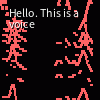I know that you can make a voice with 8-bit sine. I need to know how, and the link to Lucent's guide to Online Sequencer gives me a 404 error so you need to tell me and not just post the link.
Well I know what you are referring to. Lucent's guide is pretty in-depth, and yet it depends completely on a python script that a user named Liam made. Essentially you have to download that python script and then run that python script using the command prompt and placing your sound file as the input parameter. Note that in order to do this, you have to install Python and PIP and NumPy on your device.
In summation: a user created a program that does it all for you, and that program is not very user friendly and requires a lot of other things in order to work.
I honestly don't think it's something worth doing, especially with that amount of work.
Sometimes getting an mp3 file of a voice and converting it to MIDI would help, although there may be some "invisible notes" that dont make sound, All you have to do is select everything, and make a note longer and everything will work hopefully fine
Set your grid super fine, then just start clicking sine notes. You only need a few thousand to make something that sounds ok.
This user Amber made a voice without even really lowering the grid at all, but I'm assuming it works because of the nature if the sine instrument sounds, and how it sustains note length. This is also presumably just a direct MP3 to MIDI file conversion (rather than an MP3 to sequence file conversion, which uses a Fast Fourier Transform function).

You'll notice that this voice sequence does not have nearly as much intelligibility as the voices generated using Liam's converter. I've noticed that Liam's converter also appears to be able to adjust note volume based on the gain/amplitude of each frequency, which seems to make a great deal of difference.
If you want to make your own voice completely from scratch using just the website, be sure to watch what notes you are using. There is a pattern to how it works, as there is a specific set of harmonics and subharmonics associated with the human voice (as well as pretty much anything else that makes any kind of resonating sound). I might recommend analyzing some of the other users' voice sequences, or looking up things such as:
Harmonics,
Overtones,
or
Overtone Singing.
(I mentioned Overtone Singing because there are good videos about Overtone Singing that let you hear all of the notes that can be heard when extrapolating the human voice, which is essentially what Overtone Signing is).
Note that it will probably be incredibly difficult to actually make something that even sounds similar to a voice if you are just trying to do it from scratch. You can give it a try, but it seems pretty hard to me.
(02-11-2021, 02:53 PM)Firebolt391d Wrote: [ -> ]Well I know what you are referring to. Lucent's guide is pretty in-depth, and yet it depends completely on a python script that a user named Liam made. Essentially you have to download that python script and then run that python script using the command prompt and placing your sound file as the input parameter. Note that in order to do this, you have to install Python and PIP and NumPy on your device.
In summation: a user created a program that does it all for you, and that program is not very user friendly and requires a lot of other things in order to work.
I honestly don't think it's something worth doing, especially with that amount of work.
Unfortunately, UAC stops me from downloading those and I'm not an administrator, and if I go to change UAC settings, this is also blocked by UAC for some ungodly reason.